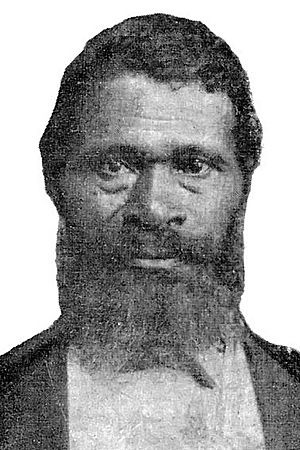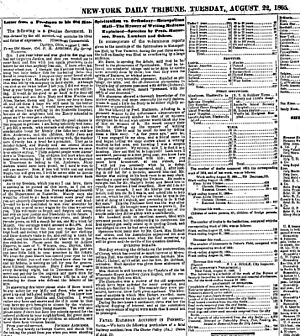Jordan Anderson facts for kids
Quick facts for kids
Jourdon Anderson
|
|
|---|---|

Author of the 1865 Letter from a Freedman to His Old Master
|
|
| Born |
Jourdon Anderson
December 1825 Tennessee, United States
|
| Died | April 15, 1907 (aged 81) Dayton, Ohio, U.S.
|
| Resting place | Woodland Cemetery |
| Nationality | American |
| Spouse(s) |
Amanda "Mandy" McGregor
(m. 1848) |
| Children | 11 |
Jordan Anderson (born in December 1825, died April 15, 1907) was an African-American man who was once enslaved. He is famous for a letter he wrote in 1865. This letter, called "Letter from a Freedman to His Old Master," was a reply to his former owner, Colonel P. H. Anderson. The colonel had asked Jordan to come back to the farm to help fix it after the Civil War.
The letter is known for its clever and serious humor. Some people have even compared its style to the funny writings of Mark Twain.
Contents
Jordan Anderson's Life Story
Jordan Anderson was born in December 1825 in Tennessee. In 1848, he married Amanda (Mandy) McGregor. They had 11 children together.
In 1864, during the American Civil War, soldiers from the Union Army came to the Anderson farm. They freed Jordan Anderson from slavery. After gaining his freedom, he may have worked at a military hospital in Nashville, Tennessee.
Later, he moved to Dayton, Ohio, with help from a doctor named Clarke McDermont. In Dayton, Jordan Anderson worked as a servant, janitor, or coachman. From 1894 until his death, he worked as a sexton. This job usually means taking care of a church building. He likely worked at the Wesleyan Methodist Church.
The Famous Letter
In July 1865, the Civil War had just ended. Colonel P. H. Anderson, Jordan's former owner, wrote to him. The colonel asked Jordan to return to the Tennessee farm. The farm was in bad shape after the war. Harvest time was coming, and the colonel needed help.
On August 7, from his new home in Ohio, Jordan Anderson replied. He dictated his letter to his employer, Valentine Winters. Winters was an abolitionist, meaning he was against slavery. The letter was then printed in a newspaper called the Cincinnati Commercial. It quickly became very popular. Other newspapers, like the New York Daily Tribune, also printed it.
In his letter, Jordan Anderson explained that his life in Ohio was much better. He asked his former master to show he was truly sorry. Jordan asked for the back wages he and his wife were owed. They had worked for many years without pay, a total of 52 years combined.
He also asked if his daughters would be safe and able to get an education. He worried about their safety, saying he would rather die than have them harmed. He reminded the colonel of what happened to "poor Matilda and Catherine." The letter ended with a memorable line: "Say howdy to George Carter, and thank him for taking the pistol from you when you were shooting at me."
People Mentioned in the Letter
The people Jordan mentioned in his letter were real. George Carter was a carpenter in Wilson County. "Miss Mary" was Colonel Anderson's wife, and "Miss Martha" was their daughter.
The man named "Henry" who wanted to shoot Jordan was likely Colonel Anderson's son, Patrick Henry Jr. He would have been about 18 years old when Jordan left in 1864. The two daughters, "poor Matilda and Catherine," did not go to Ohio with Jordan. What happened to them is not known.
"V. Winters" in the letter was Valentine Winters, a banker in Dayton. Jordan and his wife respected him so much that they named one of their sons Valentine Winters Anderson.
Colonel Anderson could not get his former enslaved workers to return. He sold his land for very little money to pay off his debts. Two years later, he died at age 44. Even in 2006, some of the colonel's living relatives were still upset that Jordan did not come back.
Jordan Anderson's Death
Jordan Anderson died in Dayton, Ohio, on April 15, 1907. He was 81 years old. He is buried in Woodland Cemetery. This is one of the oldest "garden" cemeteries in the United States. His wife, Amanda, died on April 12, 1913, and is buried next to him.
What Happened After
Dr. Valentine Winters Anderson, Jordan's son, was a close friend of Paul Laurence Dunbar. Dunbar was a famous African-American writer. In one of Dunbar's short stories, "The Wisdom of Silence," there is a character named "Jeremiah Anderson." This character is asked by his old master to return to the farm, but he refuses, just like Jordan Anderson.
A historian named Michael Johnson checked the facts in Jordan's letter. He found that slave records from 1860 showed a Colonel P. H. Anderson in the correct county. Some of his enslaved people matched the ages and genders mentioned in the letter. Jordan Anderson, his wife, and children also appeared in the 1870 census in Dayton. They were listed as Black and born in Tennessee.
A professor named Roy E. Finkenbine was planning to write a book about Jordan Anderson in 2012.
See also
 In Spanish: Jordan Anderson para niños
In Spanish: Jordan Anderson para niños
- List of slaves


